Galaxy Lesson
Galaxies, clusters, super-clusters and novas galore are measured, explored,
and craftily recreated in our hands-on galaxy lesson and worksheet.
Free Download Below
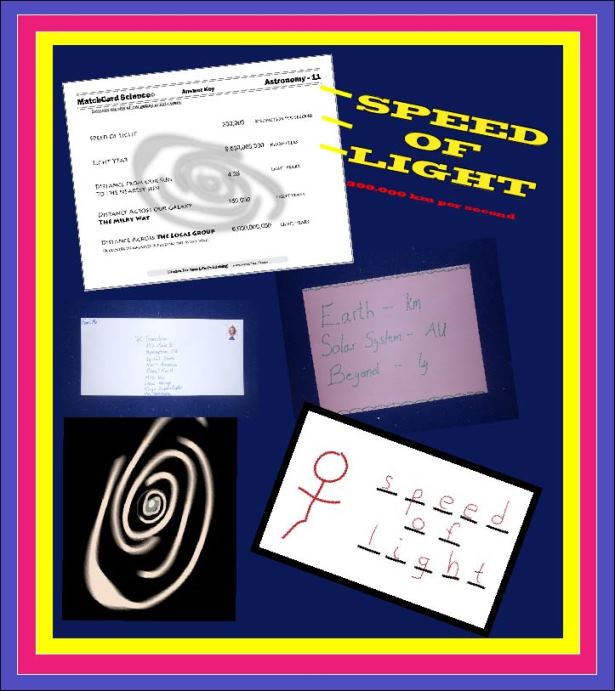
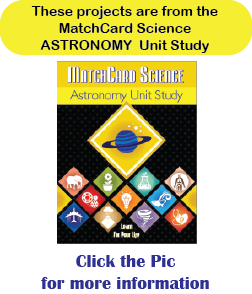
Galaxy MatchCard
Objective: Evaluate the size of our galaxy in light years.MatchCard: Download below.
Content covered includese:
- Speed of Light
- Light Years
- Astronomical Unit (reviewed from Lesson 2)
- Proxima Centauri
- Galaxy
- Milky Way
- Classification of Galaxies
- Cluster
- The Local Group
- Andromeda and Triangulum Galaxies
- Superclusters
- Virgo Supercluster
- Nebula
Download and use the Galaxy MatchCard
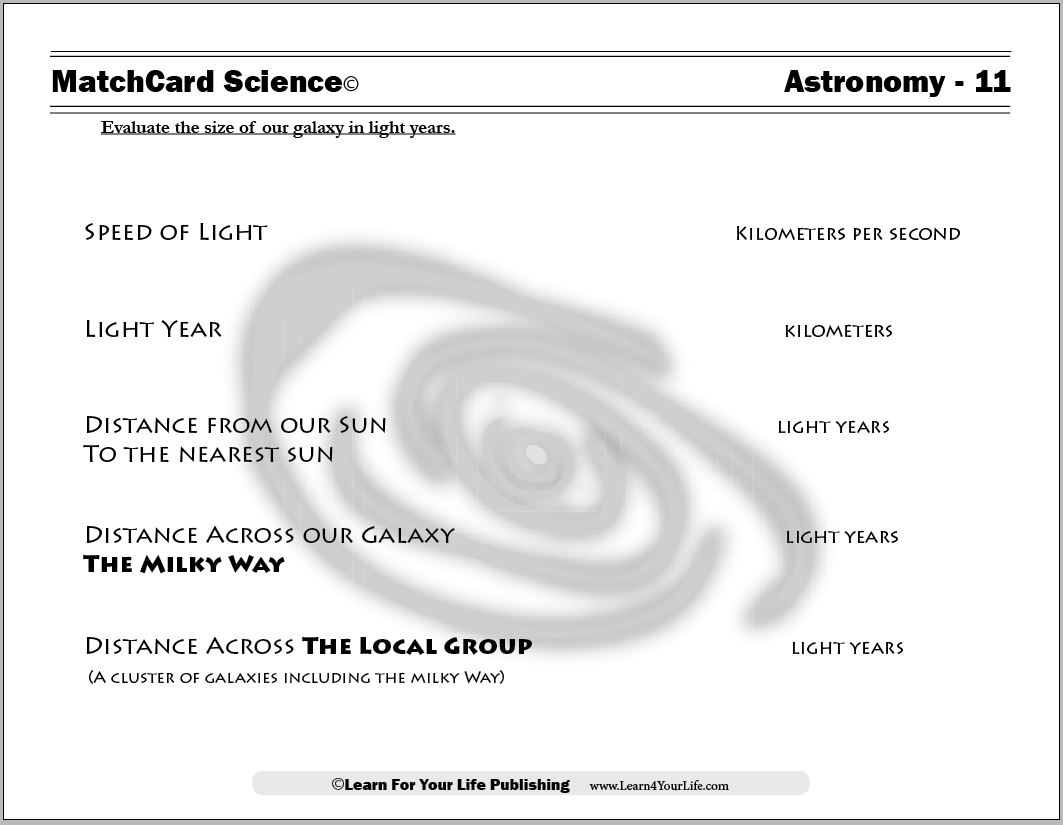

Click image to go to download.
This is MatchCard #11 of the Astronomy Unit Study. Find more information on MatchCard Science below.
Let's Teach: The Speed of Light
Opening Activity
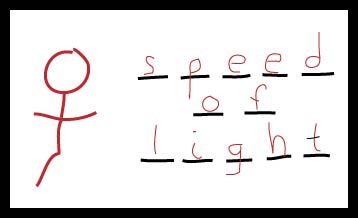
The phrase the student(s) needs to guess:
Speed of Light
How Fast Is the Speed of Light?
300,000 km per second
For a fun activity for younger students, turn off the lights, have them face away from you. Instruct them to call out “Now” the moment you turn a flashlight on. You could also try it with a weaker light like a pen light or lighter.Explain that they did not see it at the exact time you turned it on. It takes time for light to travel.
How much time? 300,000 kilometers per second is the speed of light.
For comparison, the circumference of the earth is 40,000 kilometers. (Extra info for teachers. Diameter of the Earth is approximately 12,700 km, but that would be going through the core not around the surface. One mile equals 1.61 km. One kilometer equals 0.62 miles. )
So at the speed of light, the light from your flashlight would theoretically circle the globe 7.5 times in one second.
Whoa! Just think of how much you could get done if you were that fast!
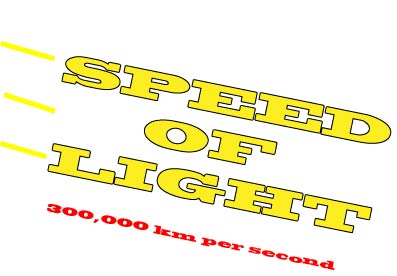
How Long Does It Take the Sun's Light to Reach Earth
We learned in Astronomy MatchCard #2 Planets in the Solar System that the distance from the Sun to Earth was 150,000,000 kilometers (1 astronomical unit or AU.)Ask the students to do the math to calculate how long it takes those electromagnetic waves traveling at the speed of light (300,000 miles per second) to reach earth.
Answer: 500 seconds or 8 minutes and 20 seconds.
How Long Does It Take the Sun's Light to Reach The End of the Solar System
Pluto is 5,900,000,000 kilometers from the sun. How long would it take light to reach Pluto from the sun?Yes we realize there is a debate about Pluto's status as a planet. See our definition of a planet lesson for more information. But there is no debate that Pluto is at the outer limits of our solar system - at least as we know it yet.
Answer: It takes almost 5 1/2 hours for the sun’s light to reach Pluto and the outer reaches of our solar system.
Let's Teach: Light Years
9,500,000,000,000 Kilometers
Note: Light years is a measurement of distance, not of time. It is the distance light would travel in one year at the rate of 300,000 km per second.Opening Activity
It may not be the most nutritious, but you’ll get no complaints if you hide miniature Milky Way candy bars for them to find. Explain you will be measuring candy in light years later.Calculators, Please!
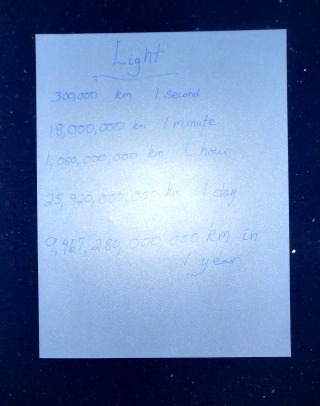
- One minute (x60)
- One hour (x60)
- One day (x24)
- One year (x 365.25) That 1/4 day for leap year makes a difference here. Answer=9,467,280,000,000
What's a Trillion?
You can use a calculator again to show that one billion seconds is almost 32 years (use the 365.25 days for years.)That would mean one trillion seconds would take 32,000 years.
Measurement Chart
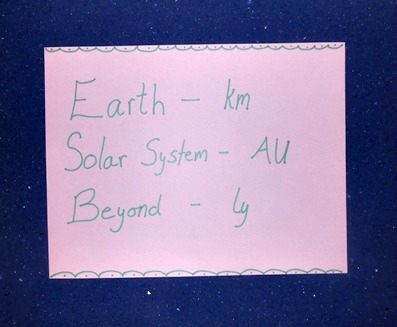
This might be another chart useful to your students to make:
- On Earth - we measure in kilometers (km)
- In the Solar System - astronomical units (AU)
- Outside the solar system - light years (ly)
The symbol for light year is ly.
Distance To Our Nearest Solar Neighbor
Nearest Star: Proxima Centauri
Outside of our solar system, our nearest known neighbor is a star named Proxima Centauri. It would take a mere 4 1/2 years traveling at the speed of light to stop by for a visit. If you don’t have the time for that visit, you might like to write a paragraph about this or another star.How Far to Nearest Star in Light Years
4.5 ly from our sun to Proxima Centauri
Remember that one Astronomical Unit is the distance from the sun to the Earth. Show one milimeter on a centimeter ruler. It is the thickness of one dime.One light year is equal to approximately 63,000 AU’s.
Take the centimeter ruler outside. Show that if your mailbox (or any other object) was the sun, and the Earth is one milimeter (1 AU) away, Pluto would be 4 cm (40 milimeters or 40 AU), and the nearest star would be 63 meters away (63,000 milimeters or 207 feet.)
Galactic Putty
Make some galactic putty which you will use in the next session on galaxies.- 2 cups water
- blue food coloring (or blue and red to make purple)
- 1 tablespoon cream of tartar
- 1 cup of salt
- 2 cups of flour
- glitter: silver, gold, and/or diamond dust.
Heat the dyed water just to boiling
Add the dry mixture. Mix until dough forms. Knead the dough in the glitter.
Let them play with it for a while. We will use it in the next session below on teaching about galaxies.
Let's Teach: Galaxies
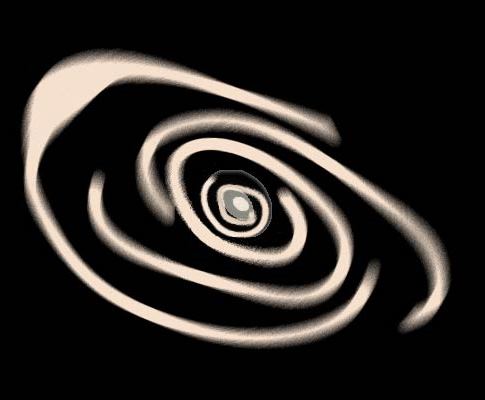
Galaxy In A Jar
If you can have a Pet Tornado In A Jar you can also have a Pet Galaxy. Here's how:- Glass or transparent plastic container with lid (Baby food jar or spaghetti sauce jar would be great.)
- Dark blue dye
- Water
- 1 tablespoon oil (baby or corn oil)
- Silver, gold, or diamond dust glitter (see ad above)
Watch the “stars” slowly settle in a galactic spiral.
What Is A Galaxy?
A galaxy is a massive group of starts that are bound together by a gravitational force. There are billions of stars in a galaxy.Our solar system is part of the Milky Way galaxy. We are towards the edge of the galaxy, and the rest of the galaxy forms a milky cloud that can be seen in the night sky.
Have you ever traveled by plane at night and seen how the lights of a city can be seen from miles away. This is because their are millions of lights burning in that city. This can be compared to the lights of a galaxy.
Classification of Galaxies
Hubble divided galaxies into three types based on their shapes. These types can be further subdivided.SPIRAL GALAXIES
These are the most famous types and include our Milky Way. The arms of the galaxy swing outward.S Spiral Galaxies
The spirals start in the center and spread out from there.SB Spiral Galaxies
These are the Spiral Bar Galaxies. The center has a bar or thin rectangular shape in the center, and the spirals extend from the two ends of the bar. Look closely at the Milky Way.ELIPTICAL GALAXIES
An elipse is a circular shape without the spirals. These are further subclassified from 0 (a perfect circle) to 7 (a squashed oval shape.)IRREGULAR GALAXIES
The irregular galaxies are just like one would expect: irregular and unusual shapes that do not fit the spiral or eliptical classifications.Activity for 3 Types of Galaxies
Do an internet search for pictures of different galaxies. In which of the 3 classes would you place them?Shape Your Own Galaxy
Use the galactic putty you made yesterday to make galaxies with the different shapes.Across the Milky Way
Go back to the comparison from AU to ly, with one AU equal to 1 mm and the nearest star 63 meters away.The distance across our galaxy would be greater than 2 kilometers or about 1.3 miles. (Remember, that is on a scale where the distance from the sun to Earth is one mm.)
Distance Across the Local Group
The Local Group is a cluster of galaxies. There are over 50 galaxies in the Local Group, with The Milky Way, the Andromeda Galaxy, and the Triangulum Galaxy are the largest. You might like to look for pictures of Andromeda on the internet. You can also look to see where it is located on Google Sky app for smart phones.Superclusters
A supercluster can be considered a galaxy of galaxies. The Local Group is within the Virgo Supercluster.My Intergallactic Address
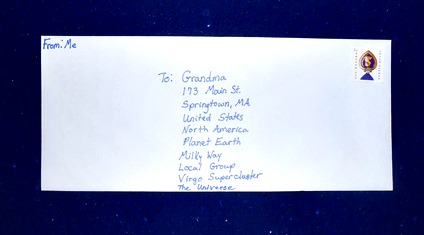
- Name
- Street Address
- Town, State, ZipCode
- Country
- Continent
- Earth
- Our Solar System
- Milky Way Galaxy
- Local Group
- Virgo Supercluster
- The Universe
Discussion Questions
Do you think there may be other layers of the Virgo Supercluster that our galaxy is within?Do an internet search for Virgo Supercluster. What did you find?
Could there be something bigger that the universe is within?
What is a Nebula?
A nebula is a cloud of gas visible in the night sky. Nebula are associated with galaxies and superclusters because of the “star dust” and debris surrounding galaxies. The word nebula basically means “fuzzy cloud.”Nebula In A Jar
Here's how to make your Pet Nebula In A Jar- Small transparent jar with lid
- Glow Stick
- Diamond Dust Glitter
MatchCard Science
How To Use MatchCards

Download the FREE MatchCard Science Instructor's Guide and see how MatchCards can make building their science knowledge base fun.
Astronomy Unit Study
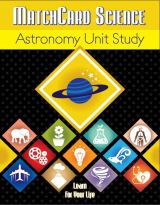
Explore the universe with the MatchCard Science Astronomy Unit Study..
12 Science Unit Studies

Chemistry is only one of twelve complete unit studies for kids in 3rd to 8th grade.
Comprehensive objectives, hands-on projects, suggested science fair experiments, and the fun game-like MatchCards keep them interested in learning science. See all twelve MatchCard Science Unit Studies.
About Our Site
Hands-On Learning













